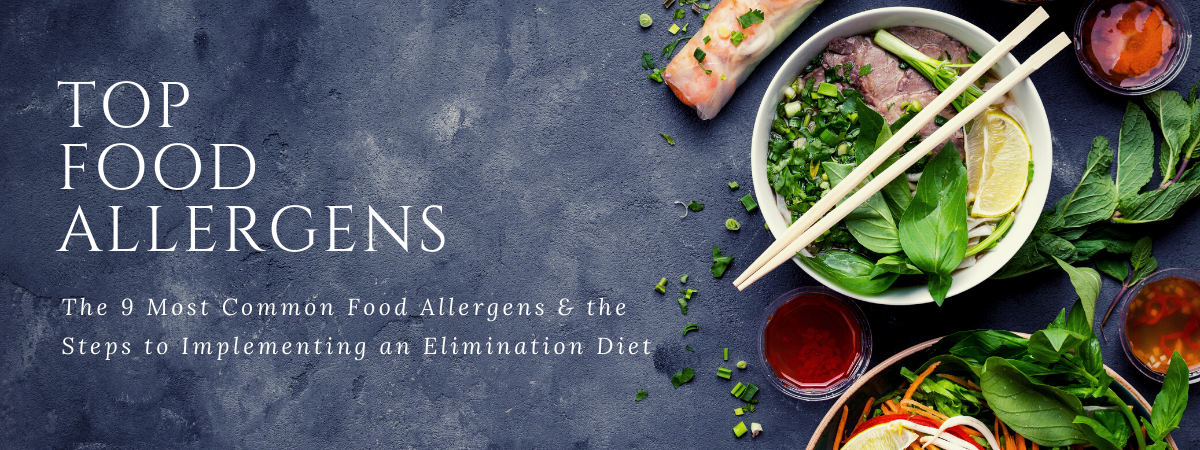Top Food Allergens & Implementing an Elimination Diet
According to recent statistics, approximately 10.8% of Americans suffer from food allergies. (1) A food allergy is an IgE immune response whereby the body identifies it as an invader which creates an allergic reaction. Some of the symptoms that might occur include hives, itchiness, swelling, throat tightening, and difficulty breathing. If an IgE-mediated food allergy is suspected, it is advised to do testing with an Allergist or Physician to identify the allergen, as it can be life-threatening. Consuming even a small bite or exposure through cross-contamination or inhalation can cause an anaphylactic response in some people. For this reason, extreme caution needs to be taken when reading food labels to identify any known allergies. In 2004, the Food Allergen Labeling Consumer Protection Act (FALCPA) was established. (3) This law requires that all food labels identify any major food allergen by listing it in the ingredient list or making a statement that it contains an allergen. The label may include an advisory statement if the food product was made in a facility that uses a particular allergen, but this is not required.
Top 9 Food Allergens:
The current list of top food allergens includes the following items: (listed from most to least prevalent)
- Shellfish ( such as shrimp, crab, and lobster)
- Cow’s Milk
- Peanuts
- Tree Nuts
- Eggs
- Finned Fish (such as cod, salmon, and tilapia)
- Wheat
- Soy
- *Sesame*
*Note, the latest allergen of concern is sesame. (2) In April 2021, the Food and Allergy Safety, Treatment, Education Research (FASTER) Act identified and signed into law, sesame as the 9th major food allergen. The mandate for identifying sesame as an allergen on the food label will go into effect on Jan 1, 2023. (3)
Food Sensitivities
Some people may not have a true food allergy, but rather a food sensitivity to certain foods or additives. These may include sensitivity or intolerances to gluten, dairy, caffeine, nitrates, sulfites, or other additives. In contrast to a food allergy, which presents with immediate Immune symptoms, a food sensitivity will have symptoms that come on more slowly. These symptoms may present as gastrointestinal issues such as gas, bloating, diarrhea, or constipation, but can also include skin conditions, migraines, or other reactions.
Elimination Diets
One of the best tools for helping individuals determine specific food culprits and intolerances is an elimination diet. There are a variety of different elimination diets that might be used depending on a person’s symptoms and medical history. There are certain foods and food groups that are more problematic as they relate to specific conditions such as Irritable Bowel Syndrome, gastroesophageal reflux disorder (GERD), migraines, and some auto-immune disorders. For this reason, a variety of elimination diets exists. Some of the more common elimination diets include a low FODMAP diet, GERD elimination diet,
Gluten-Free, Dairy-Free diet, Low Histamine diet, and a Comprehensive Elimination diet (which often excludes the top 8-9 allergens plus additional foods such as caffeine and corn and additives such as artificial coloring, etc). Elimination diets should be used short-term to determine individual intolerances.
The goal is to identify the least restrictive diet regimen you can tolerate while managing any symptoms.
 Phases of an Elimination Diet:
Phases of an Elimination Diet:
- Select the appropriate elimination diet based on one’s symptoms and any medical condition.
- Avoid the foods, food groups, or specific additives for 2-4 weeks and monitor changes in symptoms. If symptoms remain within the 2-week period, continue the elimination diet for another 2 weeks.
- Once symptoms resolve, start a systematic food reintroduction challenge to identify triggers and intolerances.
- Only challenge 1 food at a time over a 1-3 day period with increasing portions during the day or over the 3-day period as advised; then wait 3 days before moving on to a new food or food group.
- Keep a detailed food journal and symptom log during the reintroduction phase to record any symptoms (gas, bloating, diarrhea, constipation, etc) you may experience during this phase.
- Continue to adhere to the elimination diet throughout the reintroduction challenge.
- After the completion of the elimination diet, utilize the information gathered to design one’s
personalized eating plan.
If you suspect you may have a food allergy or food sensitivity, reach out to one of the Dietitians at Nutrition Healthworks to help you navigate an elimination diet, food sensitivity testing, or make a referral for an MD/allergist as needed.

Ann Sukany-Suls
MEd, RDN, LD - Mooresville NC
Ann Sukany-Suls is a Licensed and Registered Dietitian Nutritionist with a Master’s Degree in Counseling and over 30 years of experience. Ann specializes in weight management and medical nutrition for chronic disease and GI disorders. READ MORE
References:
1. Gupta RS, Warren CM, Smith BM, Jiang J, Blumenstock JA, Davis MM, Schleimer RP, Nadeau KC. Prevalence and Severity of Food Allergies Among US Adults. JAMA Network Open 2019; 2(1):e185630.doi:10.1001/jamanetworkopen.2018.5630.
2. Warren CM, Chadha AS, Sicherer SH, Jiang J, Gupta RS. Prevalence and Severity of Sesame Allergy in the United States. JAMA Network Open 2019; 2(8):e199144. doi: 10.1001/jamanetworkopen.2019.9144.
3. www.fda.gov/food/food-labeling-nutrition/food-allergies
4. www.webmd.com/allergies/allergies-elimination-diet



